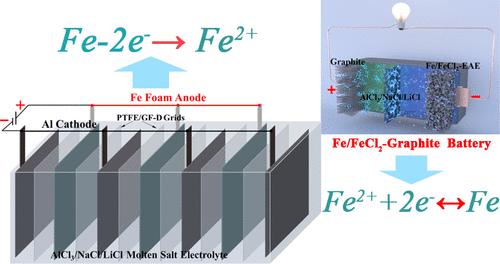当前位置:
X-MOL 学术
›
ACS Appl. Mater. Interfaces
›
论文详情
Our official English website, www.x-mol.net, welcomes your
feedback! (Note: you will need to create a separate account there.)
Anodic Electrolysis Strategy Enabled Fe/FeCl2 Electrode for Scalable Fe/FeCl2-Graphite Molten Salt Battery
ACS Applied Materials & Interfaces ( IF 8.3 ) Pub Date : 2024-06-03 , DOI: 10.1021/acsami.4c03592 Wenlong Zhang 1 , Huanxin Li 2, 3 , Xiaohui Ning 1
ACS Applied Materials & Interfaces ( IF 8.3 ) Pub Date : 2024-06-03 , DOI: 10.1021/acsami.4c03592 Wenlong Zhang 1 , Huanxin Li 2, 3 , Xiaohui Ning 1
Affiliation

|
The Fe/FeCl2-Graphite molten salt battery is a promising technology for large-scale energy storage, offering a long lifespan, a low operating temperature (<200 °C), and cost efficiency. However, its practical applications are hindered by the lack of a scalable preparation approach and insufficient redox stability in the Fe/FeCl2 electrode. Our study introduces an electrochemical anodic electrolysis (EAE) strategy, employing the anodic process (Fe → Fe2+) in an Al|AlCl3/NaCl/LiCl|Fe electrolysis system for the Fe/Fe2+ negative electrode in the Fe/FeCl2-Graphite battery. The EAE strategy forms an oxidized film, preventing incipient dissolution in the electrolyte and addressing redox stability issues with FeCl2 as the active substance. The Fe/Fe2+ negative electrode prepared by the EAE strategy exhibits a stabilized capacity of 0.72 mAh/cm2 after 7000 cycles at 5 mA/cm2, with a lower polarization level (∼29 mV) compared to FeCl2 as the active component. The flexibility of the EAE strategy is validated in both galvanostatic and potentiostatic processes, with a discharge capacity of 14 mAh after 1000 cycles, a capacity retention rate of 85%, and a Coulombic efficiency of 98% in the potentiostatic anodic electrolysis Fe/Fe2+ electrode. The scalability and reliability of the EAE strategy are further demonstrated in capacity-expanded Fe/FeCl2-Graphite batteries, reaching a discharge capacity of 155.1 mAh after 1000 cycles at 130 mA, with a capacity retention rate of 94%. For the first time, we showcased an EAE approach capable of producing Fe/Fe2+ electrodes at a rate of about 68.6 m2 per day. Additionally, we successfully assembled an Fe/FeCl2-Graphite battery at about a 0.42 ampere-hour level, paving the way for the scalable application of Fe/FeCl2-Graphite batteries.
中文翻译:

用于可扩展 Fe/FeCl2-石墨熔盐电池的阳极电解策略 Fe/FeCl2 电极
Fe/FeCl 2 -石墨熔盐电池是一种有前途的大规模储能技术,具有长寿命、低工作温度(<200 id=41>2电极。我们的研究引入了电化学阳极电解(EAE)策略,在Al|AlCl 3 /NaCl/LiCl|Fe电解系统中采用阳极过程(Fe → Fe 2+ )作为Fe/FeCl 2 -石墨电池中的Fe/Fe 2+负极,形成EAE策略。通过EAE策略制备的Fe/Fe 2+负极在7000次循环后表现出0.72 mAh/cm 2的稳定容量。 5 mA/cm 2 ,与作为活性成分的 FeCl 2相比,具有较低的极化水平(~29 mV)。EAE 策略的灵活性在恒电流和恒电位过程中得到了验证,1000 次循环后的放电容量为 14 mAh。恒电位阳极电解Fe/Fe 2+电极的容量保持率为85%,库仑效率为98%。 EAE策略的可扩展性和可靠性在扩容的Fe/FeCl 2 -石墨电池中得到进一步证明,在130 mA下循环1000次后放电容量达到155.1 mAh,容量保持率为94%。我们首次展示了能够以每天约 68.6 m 2的速度生产 Fe/Fe 2+电极的 EAE 方法。此外,我们还成功组装了约 0 的 Fe/FeCl 2 -石墨电池。42安时水平,为Fe/FeCl 2 -石墨电池的可扩展应用铺平了道路。
更新日期:2024-06-03
中文翻译:

用于可扩展 Fe/FeCl2-石墨熔盐电池的阳极电解策略 Fe/FeCl2 电极
Fe/FeCl 2 -石墨熔盐电池是一种有前途的大规模储能技术,具有长寿命、低工作温度(<200 id=41>2电极。我们的研究引入了电化学阳极电解(EAE)策略,在Al|AlCl 3 /NaCl/LiCl|Fe电解系统中采用阳极过程(Fe → Fe 2+ )作为Fe/FeCl 2 -石墨电池中的Fe/Fe 2+负极,形成EAE策略。通过EAE策略制备的Fe/Fe 2+负极在7000次循环后表现出0.72 mAh/cm 2的稳定容量。 5 mA/cm 2 ,与作为活性成分的 FeCl 2相比,具有较低的极化水平(~29 mV)。EAE 策略的灵活性在恒电流和恒电位过程中得到了验证,1000 次循环后的放电容量为 14 mAh。恒电位阳极电解Fe/Fe 2+电极的容量保持率为85%,库仑效率为98%。 EAE策略的可扩展性和可靠性在扩容的Fe/FeCl 2 -石墨电池中得到进一步证明,在130 mA下循环1000次后放电容量达到155.1 mAh,容量保持率为94%。我们首次展示了能够以每天约 68.6 m 2的速度生产 Fe/Fe 2+电极的 EAE 方法。此外,我们还成功组装了约 0 的 Fe/FeCl 2 -石墨电池。42安时水平,为Fe/FeCl 2 -石墨电池的可扩展应用铺平了道路。


















































 京公网安备 11010802027423号
京公网安备 11010802027423号